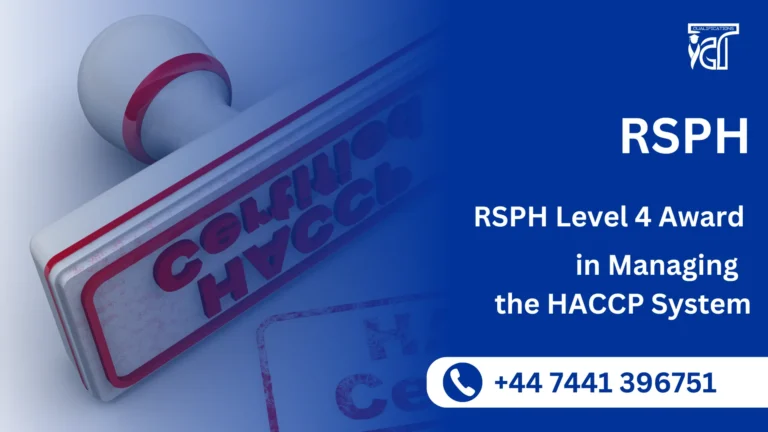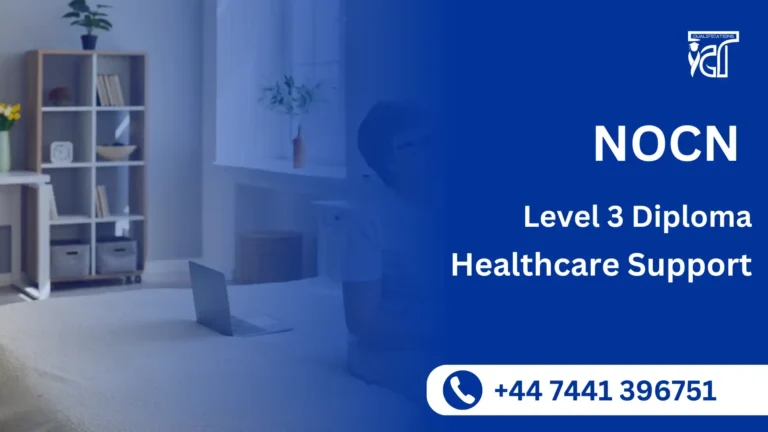Workplace safety is a fundamental responsibility for employers and employees alike. The RSPH Level 2 Award in Health and Safety in the Workplace is an Ofqual-regulated qualification designed to provide essential knowledge about health and safety legislation, risk assessment, and hazard control. This assignment-based certification ensures that learners gain practical and theoretical skills to identify and manage risks in various workplace environments.Whether you are an employer looking to train your staff or an individual seeking career progression, this course provides the knowledge necessary to ensure a safe and legally compliant workplace.
Every workplace, regardless of the industry, must comply with UK health and safety laws. This qualification helps individuals understand their responsibilities under these laws while promoting a proactive approach to safety. Employees who undergo training contribute to fewer workplace accidents, reduced legal risks, and a more productive working environment.
This qualification is ideal for employees across all sectors, providing a strong foundation in risk assessment, hazard identification, and safe work practices. By completing this course, individuals gain critical knowledge that helps protect themselves and others in the workplace.
The RSPH Level 2 Award in Health and Safety in the Workplace is a valuable qualification for individuals and businesses aiming to create safer working environments. This course provides practical knowledge on risk management, legal compliance, and emergency response, ensuring employees and organizations can effectively handle workplace hazards.By investing in health and safety training, businesses can reduce accidents, improve employee morale, and stay legally compliant, while individuals gain a competitive advantage in their careers.
RSPH Level 2 Award in Health and Safety in the Workplace
RSPH Level 2 Award in Health and Safety in the Workplace is one week training program consist of 7 Hours GLH (Guided Learning Hours) and 9 Hours TQT (Total Qualification Time).
| Sr# | Unit Title |
|---|---|
| 1 | Roles and responsibilities for health, safety and welfare in the workplace |
| 2 | How risk assessments contribute to health and safety |
| 3 | How to identify and control the risks from common workplace hazards |
| 4 | Procedures for responding to accidents and incidents in the workplace |
GLH (Guided Learning Hours) and TQT (Total Qualification Time) are terms commonly used in vocational qualifications to help define the amount of time a learner is expected to spend on their studies.
1. GLH (Guided Learning Hours)
GLH refers to the number of hours a learner spends being directly taught, supervised, or supported during their course. This includes the time spent in activities such as:
- Classroom instruction
- Practical workshops
- One-on-one tutoring or mentoring sessions
- Online learning sessions with tutor support
In other words, GLH represents the time that learners are actively engaged with their instructors or learning activities.
2. TQT (Total Qualification Time)
TQT represents the total amount of time a learner is expected to invest in completing a qualification, including:
- GLH (Guided Learning Hours): Time spent on direct learning, as explained above.
- Self-Directed Learning: This includes time spent on independent study, research, assignment completion, preparation for exams, and any other work the learner does outside of direct teaching hours.
TQT is a broader measure that includes all the time required to achieve the qualification. It helps learners and employers understand the overall commitment required for the qualification.
Key Differences Between GLH and TQT:
- GLH focuses on direct learning with guidance or supervision.
- TQT includes GLH as well as independent study time and other learning-related activities.
Example:
If a qualification has a TQT of 600 hours and a GLH of 250 hours, it means the learner should spend 250 hours in direct learning (classroom, online, or tutor-led sessions) and 350 hours on independent study or research.
Learning Outcomes for RSPH Level 2 Award in Health and Safety in the Workplace
1. Roles and Responsibilities for Health, Safety, and Welfare in the Workplace
- Understand the legal duties and responsibilities of employers and employees under UK health and safety law.
- Recognize the role of health and safety enforcement bodies, such as the Health and Safety Executive (HSE).
- Identify the importance of workplace policies and procedures in maintaining a safe working environment.
- Understand how effective communication and training contribute to health, safety, and welfare.
2. How Risk Assessments Contribute to Health and Safety
- Understand the purpose and process of risk assessments in preventing workplace injuries and illnesses.
- Identify the steps involved in conducting a risk assessment, including hazard identification, risk evaluation, and control measures.
- Learn how to implement the Hierarchy of Controls to minimize risks.
- Recognize the importance of record-keeping and reviewing risk assessments regularly.
3. How to Identify and Control the Risks from Common Workplace Hazards
- Identify common workplace hazards, including slips, trips, falls, fire risks, hazardous substances, manual handling, and electrical hazards.
- Understand the methods for controlling risks, such as safe systems of work, personal protective equipment (PPE), and safety signage.
- Learn how to apply workplace safety procedures to reduce accidents and promote well-being.
- Understand the impact of ergonomics and workplace design in minimizing risks.
4. Procedures for Responding to Accidents and Incidents in the Workplace
- Recognize the importance of accident reporting and investigation in improving workplace safety.
- Understand the legal requirements for recording and reporting workplace accidents (RIDDOR – Reporting of Injuries, Diseases and Dangerous Occurrences Regulations).
- Learn the correct procedures for handling workplace emergencies, including fire evacuations, first aid response, and dealing with hazardous spills.
- Understand how to support post-incident reviews to prevent future occurrences.
Benefits of the RSPH RSPH Level 2 Award in Health and Safety in the Workplace
Following are the benefits of RSPH Level 2 Award in Health and Safety in the Workplace:
- Compliance with Legal Requirements – Provides essential knowledge to comply with UK health and safety laws, including the Health and Safety at Work Act.
- Enhanced Workplace Safety – Helps reduce workplace accidents and incidents by promoting risk awareness and hazard control.
- Career Advancement – Recognized qualification that enhances job prospects in various industries, including construction, healthcare, hospitality, and retail.
- Increased Employee Confidence – Equips individuals with the knowledge to identify hazards, perform risk assessments, and implement safety measures.
- Improved Productivity – A safer work environment leads to fewer disruptions due to injuries or accidents, improving overall efficiency.
- Universal Applicability – Suitable for employees across all industries, making it a valuable certification for any workplace setting.
- Boosts Employer Reputation – Employers benefit from a well-trained workforce that prioritizes health and safety, reducing legal risks and improving company reputation.
- Foundation for Further Training – Acts as a stepping stone for higher-level health and safety qualifications, such as the RSPH Level 3 Award in Health and Safety.
Best Fit for theRSPH Level 2 Award in Health and Safety in the Workplace
The RSPH Level 2 Award in Health and Safety in the Workplace is ideal for a variety of individuals and organizations aiming to improve health and safety standards in the workplace. This qualification is best suited for:
- Employees in Entry-Level or Supervisory Roles – Workers across various industries who need a foundational understanding of health and safety practices and regulations to perform their duties safely.
- Managers and Supervisors – Those responsible for the health and safety of a team, ensuring that workplace risks are minimized and safety procedures are followed.
- HR Professionals – HR personnel looking to enhance their understanding of workplace safety and incorporate health and safety measures into their organizational policies.
- Health and Safety Enthusiasts – Individuals looking to start a career in health and safety or take their knowledge to the next level.
- Small Business Owners and Employers – Business owners in industries where safety is a key concern, helping them maintain a safe environment for employees and customers while complying with legal requirements.
- Anyone Working in High-Risk Environments – Employees in sectors like construction, manufacturing, healthcare, hospitality, and logistics, where understanding safety procedures is essential for minimizing risks and preventing accidents.
- Organizations with Legal and Compliance Requirements – Companies looking to meet health and safety regulations and ensure that their teams understand their roles in creating a safe working environment.
Entry Requirements
Register Now
Qualification Process
Qualification Process for the RSPH Level 2 Award in Health and Safety in the Workplace
- Self-Assessment:
Begin by evaluating your eligibility to ensure you meet the qualification requirements, including work experience, knowledge, and language proficiency. - Registration:
Complete your registration by submitting the required documents, including a scanned copy of a valid ID, and paying the registration fee. - Induction:
An assessor will conduct an induction to confirm your eligibility for the course and explain the evidence requirements. If you do not meet the criteria, your registration will be canceled, and the fee will be refunded. - Assignmnets & Evidence Submission:
Provide all assignmnets and the necessary evidence based on the assessment criteria outlined in the course. If you are unsure of the required evidence, consult with the assessor for guidance on the type and nature of evidence needed. - Feedback and Revision:
The assessor will review your submitted evidence and provide feedback. Evidence that meets the criteria will be marked as “Criteria Met,” while any gaps will be identified. You will be asked to revise and resubmit if needed. - Competence Evidence:
Submit final evidence demonstrating that all learning outcomes have been met. This evidence will be marked as “Criteria Met” by the assessor once it is satisfactory. - Internal Quality Assurance (IQA):
The Internal Quality Assurance Verifier (IQA) will review your evidence to ensure consistency, quality, and compliance with standards. - External Verification:
The IQA will submit your portfolio to RSPH External Quality Assurance Verifiers (EQA) for final confirmation. The EQA may contact you directly to verify the authenticity of your evidence. - Certification:
Upon successful completion of all checks, RSPH will issue your official certificate, confirming that you have attained the RSPH Level 2 Award in Health and Safety in the Workplace.







